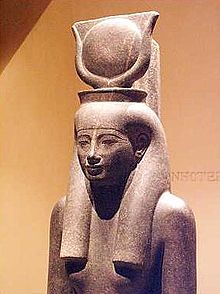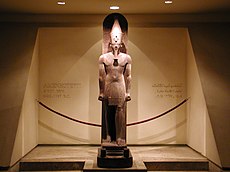Luxor statue cache
Appearance

The Luxor statue cache (also known as the Dush Treasure) is a grouping of Ancient Egyptian statues unearthed in 1989.[1] They were discovered in Luxor, beneath the solar court of the 18th dynasty Pharaoh Amenhotep III.
Partial list of statues

- Thutmosis III as sphinx, alabaster, 1.095 metres (3 ft 7 in)
- Amenhotep III, standing, red quartzite, 2.49 metres (8 ft 2 in)
- the goddess Iunyt, seated, grey granite 1.45 metres (4 ft 9 in)
- Tutankhamun as sphinx, alabaster (with paint remains) 0.56 metres (1 ft 10 in)
- Horemheb, kneeling holding offering pots, diorite 1.91 metres (6 ft 3 in)
- Amun-Re-Kamutef serpent, grey granite 1.52 metres (5 ft 0 in)
- Amun-Re-Kamutef serpent, grey granite 1.00 metre (3 ft 3 in)
- Goddess Taweret, sandstone, 0.61 metres (2 ft 0 in)
History of find
The excavation was launched in 1989 under the authority of Mahammed el-Saghir, with routine maintenance by the Luxor antiquities inspectorate. The Luxor cache was buried during the Roman conversion of the area into a military camp.[2] Originally five statues were found at a three foot depth below a covering layer of small stones; eventually 26 statues were uncovered with some being damaged prior to burial.
-
Amenhotep III, standing upon Sled, (of God Tem, oldest creator god-(Atum))
-
Horemheb kneeling
Notes
References
- Reeves, Nicholas (2000). "The Luxor Statue Cache". Ancient Egypt, The Great Discoveries, a Year-by-Year Chronicle. London: Thames and Hudson Ltd. pp. 226–228. ISBN 0-500-05105-4.


